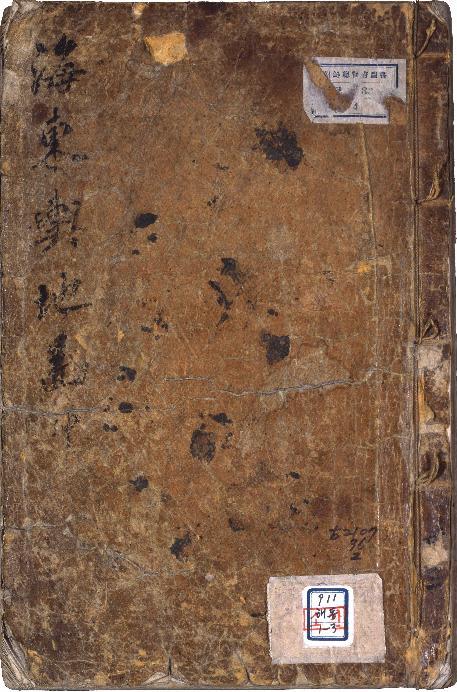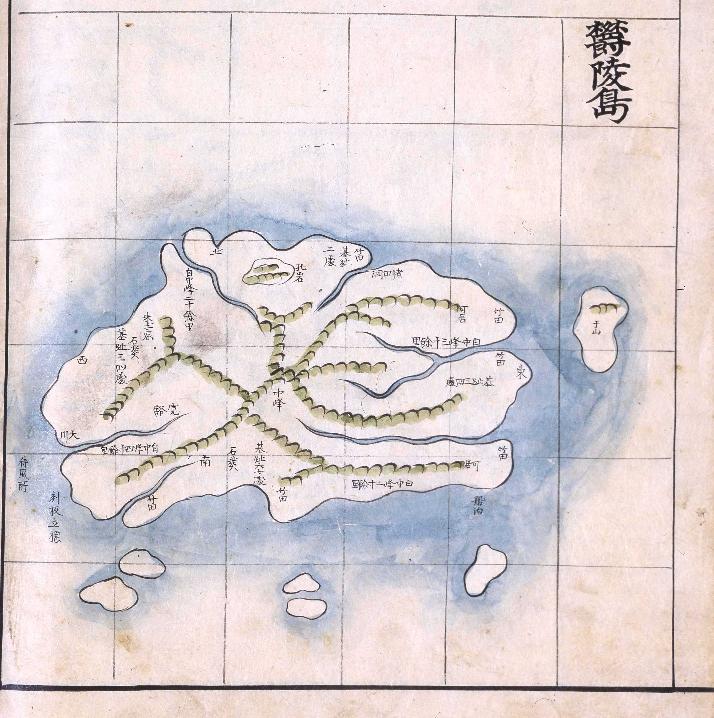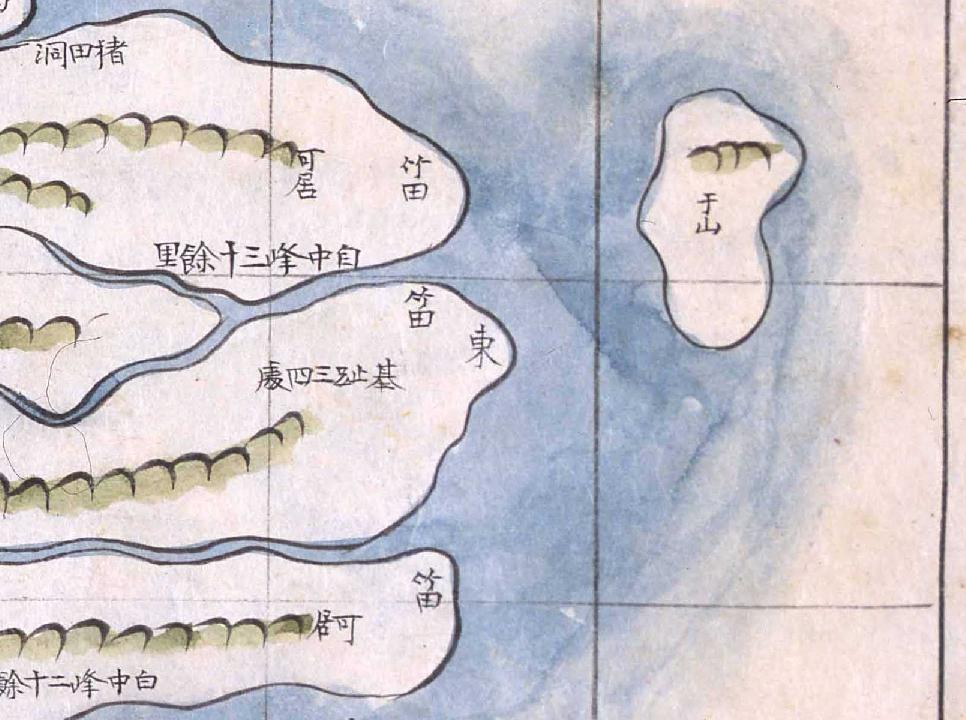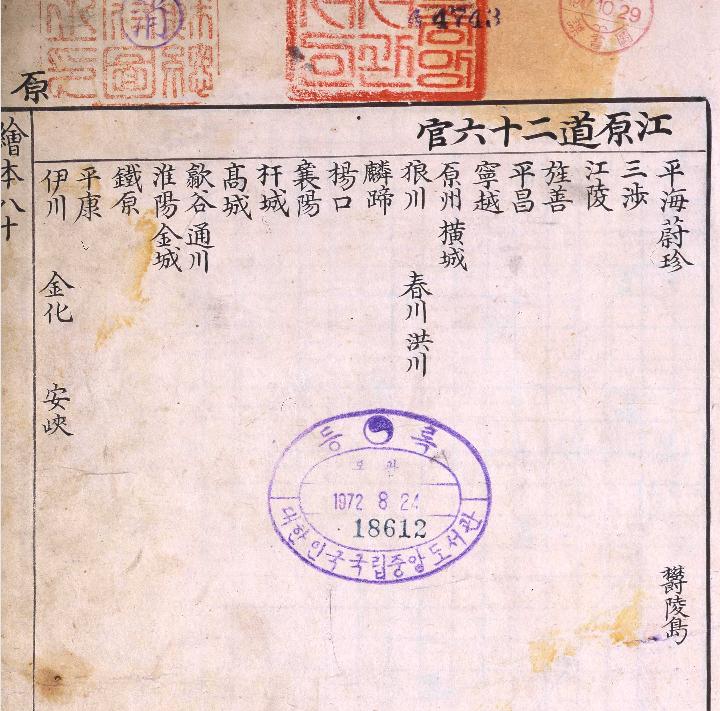 The map below is of the Korean island of Ulleungdo (鬱陵島). It comes from the atlas "Haedong Yeojido" (海東輿地圖), which is believed to have been made sometime between 1777 and 1787. (See the photo to the left.) Kim Jong-ho"s (金正浩) 1834 map "Cheonggudo" (靑邱圖) is believed to have been modeled on the maps in this atlas. The map and atlas are stored in the National Library of Korea.
The map below is of the Korean island of Ulleungdo (鬱陵島). It comes from the atlas "Haedong Yeojido" (海東輿地圖), which is believed to have been made sometime between 1777 and 1787. (See the photo to the left.) Kim Jong-ho"s (金正浩) 1834 map "Cheonggudo" (靑邱圖) is believed to have been modeled on the maps in this atlas. The map and atlas are stored in the National Library of Korea.The map was drawn on ruled paper, which gives it scale. A small island was drawn off the east shore of Ulleungdo and labeled as "Usan" (于山). Korea claims that "Usando" (于山島) was the old Korean name for "Dokdo" (Liancourt Rocks), but this map and many others show that Usando was almost certainly Ulleungdo's neighboring island of Jukdo (竹島), which is about 2.2 kilometers off Ulleungdo's east shore.
The map also shows five small islands off the southern shore of Ulleungdo, which were commonly drawn on maps of Ulleungdo during the Joseon period (1392 - 1910). However, the five islands were almost certainly a mapping error since most of Ulleungdo's "rock islets" (石島) are located off Ulleungdo's northern shore. Nevertheless, the map shows Ulleungdo with six neighboring islands, of which Usan is the most prominent.
1777-1787 Map of Ulleungdo



Gerry ,
ReplyDeleteIn this site ,(http://yeoju.golibrary.go.kr/) 海東輿地圖 was made sometime between 1776 and 1795 . But you wrote " made sometime between 1777 and 1787 " . What are grounds?
Hi Yabutarou,
ReplyDeleteI have a Korean book entitled, "한국 고지도 발달사," that was written by Lee Sang-tae (이상태)and published in 1999. In the book, Lee claims that the atlas was made sometime between 1777 and 1787 because the placenames "산음" and "안음" were written as "산청" and "안의," and "이산" was written as "초산." He also said that "후주" was not indicated, and "금천" had not yet changed to "시흥."
"해동여지도"는 산음 - 안음이 산청 - 안의로 개칭되었고 이산이 초산으로 개칭되었는데 후주가 표기되지 않았으며 금천이 시흥으로 바꾸어 표기되지 않았음을 미루어 정저 1년(1777)부터 정조 11년(1787) 사이에 제작된 지도임을 알 수 있다.
Since the book was published in 1999, I guess it is possible that Korean scholars have have found something since then that has caused them to adjust the date up to 1795?
Yabutarou,
ReplyDeleteBy the way, where did you find the "小干島 - 大干島" map on the National Library of Korea Web site? I looked through the map section, but I could not find it. Did I miss something?
Mr,Gerry,
ReplyDeleteAccording to the Yabutarou's explanation of checking "鬱陵島図形"
1:http://www.dlibrary.go.kr/Map/main.jsp
2:Choose "11 古2702-2 고지도(古地圖)"
3:Then click on the right side upper icon of "〔8〕-2 울릉도鬱陵島"
(Click ">" twice to scroll the number from 1 to 8 and (8) icon will be shown.)
Thanks, GTOMR. I found it. Did Mr. Yabutarou say how it was able to get such a big copy of it?
ReplyDeleteGerry ,
ReplyDeleteThank you. very useful. I was guessing you had gained something .
GTOMRsan,
Thank you.誰かに訳してもらおうかと思ってました。
Gerry ,
I use image editing software " paint shop pro " . Capture an image partially first, compose partial images with a layer function next.
Sorry to interrupt guys.
ReplyDeleteBut I just found Gerry's article by Sankei Shinbun on May was on their new web site. They just started to cooperate with MSN. It has a clear image of Gerry. In case there is people who doesn't know this, the site is here.
Thanks Kaneganese.
ReplyDeleteAs bad as that photo looks, the photographer had to take about a hundred photos to get one even that good. The whole time I was talking to the reporter, the photographer was circling the table snapping pictures. I could not imagine why he would need so many pictures, but I guess he was just trying to get one where the light did not shine off my bald head. After a while, I got to where I did not even notice him.
Kaneganese,
ReplyDeleteThanks, it's a superb article. Gerry looks like very gentle and wise. I hope Korean people can read this article...
(Sorry for the interruption, guys.)
Sorry for interruption again.
ReplyDeleteMay I ask about the word "可居"? The character "可" means "able (can)" or "may" and the character "居" means "reside" or "stay" or "live". So does it mean "residence"? (residable place?)
The maps of Ulleungdo from this site have drawings of houses.
http://www.pref.shimane.lg.jp/soumu/web-takeshima/takeshima04/takeshima04_01/takeshima04c.data/8442-03.pdf
http://www.pref.shimane.lg.jp/soumu/web-takeshima/takeshima04/takeshima04_01/takeshima04c.data/8443-01.pdf
Does the word "可居" mean these houses?
Sorry, my question is not a professional one, just curious.
Pacifist,
ReplyDeleteYou are not interrupting anything. You can ask whatever questions you want because I think questions help us all learn here.
As for 可居, that means " that the site is "suitable for houses." . Remember that these maps were used partially to help determine what places on Ulleungdo was suitable for living and farming. Anyway, that is how I understand it.
By the way, thank you for your kind words.
Gerry,
ReplyDeleteThanks.
How do you think these drawings of houses in these Japanese maps of Ulleungdo?
Weren't these houses drawn at the places "suitable for houses"?
Pacifist,
ReplyDeleteI have not really studied the Japanese maps, but houses were probably built in areas where the land was relatively level, and where farmers could grow food. I do not know if the houses were really there or if they were just drawn on the Japanese maps to show that those areas were suitable for houses. Maybe it would be interesting to compare the Japanese maps with the Korean?
Pacifist,
ReplyDelete"船泊可居" It could be the marker for inspector group where they can land and camp while they are travelling around Ulleundo. From many documents, we know that those inspection took many days and they didn't always seem to spend the night on the same spot. I think they needed the information in order to inspect the island safely. Or they were marking places of inhabitable place since they came to check if there were illegal squatters on the island.
And those drawings of houses in Japanese maps, it looks like some kind of huts, not hoses. I think it might be the 船小屋 for Oyas and Murakawas. They must have been fishing around the island and needed places to boil or dry abalones and sealions, or spend the night. That's what I thought.
Gerry,
I don't think it's because of you. Professional cameraman take thousand of photos and they only use few of them. I'm a member of publicity of PTA and we take hundreads photos, but we use only a few. Sometimes, my photo doesn't even get published at all. ...sigh. Anyway, I thought you look very good-looking and intelligent in that photo.
Gerry and Kaneganese,
ReplyDeleteThanks for your comments.